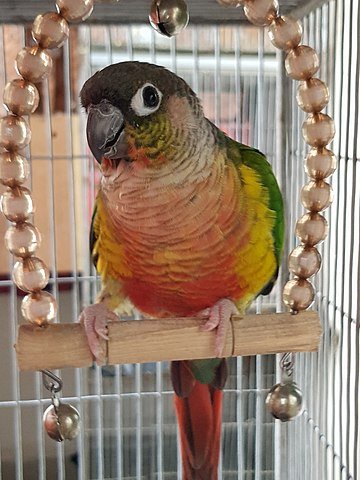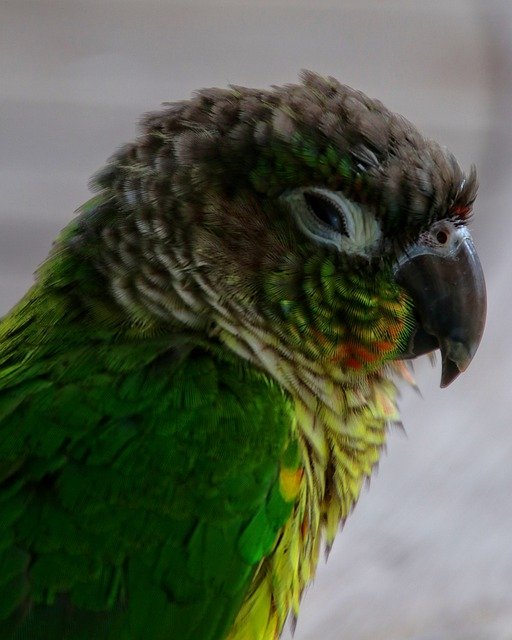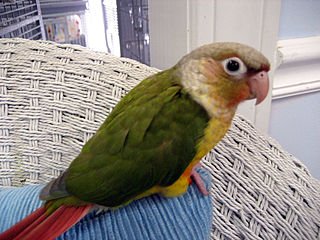Green Cheek Conures are smallest members of the conure family. They are loved among the pet owners primarily because of their varied qualities.
Green Cheek Conure Talking
Green Cheek Conures aren’t the ones from ‘frequent talking parrot club’. Yet, they can be taught a couple of words and phrases. These intelligent parrots can amass a limited vocabulary. They love human interactions and with the right techniques, these conures can certainly learn to speak.
Conures are infamous for being loud and noisy. But a green cheek is relatively quieter than other conures. He isn’t very loud, yet makes some noise.
Green Cheek Conure Talking Age
Do not expect a conure to talk the moment he is born. They take time. Green cheek conures can generally start developing their talking abilities when they’re around 2 to 3 months old. The first words they are known to utter are “up up”.
Green Cheek Conure Talking Ability
The straightforward answer to the question if the green cheek conures can talk is, yes. Green cheek conures can talk. Green cheek conures can mimic human voices. If the owner can make some effort, put in that extra time, these birds are going to learn to talk rather quickly. However, take note, not every bird is guaranteed to pick from training. Additionally, they have a soft voice that says even if they talk, they don’t utter anything understandable.
But some smart green cheek conures often quickly learn to talk with context. Some examples of their quick learning are, ‘good night’ at night, ‘hello’ when they greet you, ‘bye-bye’ when you leave for work, and ‘I love you’ very often. They are always curious about their new vocabulary lessons.
Talking about the noise factor, green cheek conures are ideal pets for the apartment dwellers. That means they don’t make too much noise that might bother the people next door. They are quieter than other conure species.
Green Cheek Conure Talking Training
Training a conure is a demanding task. But all the training sessions can be fun given the compatibility of the bird with his human trainer. Hence, the foremost thing for a successful training is a valuable bond with the bird. A strong bond is bound to make the training rewarding.
And with some fundamentals of teaching a green cheek conure to talk, the green cheek will talk back to the owner rather shortly.
Here are some foundational steps to train a green cheek conure:
Build the Bond
The initial step is to build a great bond with the conure. For that, it’s vital to make sure that his basic needs are met. Offer the right food and cage, feed him with fresh fruits, veggies, seeds, and pellets. Also, add some toys and perches.
All this helps to strike a healthy friendship with the bird. But never force anything on the bird. Give the green cheek enough time to adjust. Once he is comfortable in the new home, he would eventually want to talk to his human flock.
Build Trust
The next step is to build trust. When a green cheek starts knowing his human, it’s important to win his trust. For this purpose, be gentle with them. Do not touch or look at them directly. Be soft. Talk in a soft voice, whistle, and sing in low pitch regularly. Allow the bird to take time in developing a trust level.
Preparing for Talking Training
In order to perform advanced talking training, start with the basics. Do not go hard and fast on the conure. They are soft and expect the same from their human.
First of all, make a training schedule. Mark the daily training time and prefer sticking to it. Following a strict schedule will not only save the owner’s time but also keep the conure in the discipline. This way, the bird will look forward to his training cum bonding time with you. It is also found to make the conure response faster.
The next prerequisite is a proper environment. Just like a human needs a calm and safe atmosphere for learning, birds need them too.
For a proper environment:
Remove kids from the place to avoid any noise or distractions.
Make sure there is no loud music around.
Eliminate all other distractions and disturbances.
Basic Training: Wise Selection of Words
The correct way to encourage the bird to talk is by starting with simple words. The words must be wisely selected. Shorter the word, the easier it is to learn. The bird will always be enthusiastic to learn them for their ease. Examples for such words can be hello, hie, bye-bye, nite-nite, etc. Teach them to speak their own name also.
While training a green cheek, it is important that one’s voice seems happy and positive. Observe the bird during the training session. The response he gives can say a lot about his daily growth and learning abilities.
Repeat Training Sessions Daily
Once the green cheek starts to talk, do this every day. Stick to the set schedule and always be on time. Repeat the words that have been picked. After having observed the growth of the bird, mark the words in which the conure is interested. It’s time to continue with them. Parrots love to mimic and so do the green cheek conures. Therefore, repeated training sessions can help a lot in making a bird excel at speech.
Have Patience
Conure’s talking training can be challenging in many cases. When one performs the scheduled training and repetition technique, it’s still important to wait. Green cheek conures aren’t very fast at learning vocabulary. Despite the fact that they can memorize a limited vocabulary, they can be taught a couple of words with patience.
The reality says that it’s not a guarantee that every green cheek conure will talk. Some of them may never talk. But they surely can mimic and whistle. So, having patience and getting discouraged is the key.
With love, affection, and efforts, a green cheek conure can learn either some or all of the above speech skills.
Techniques for Developing Talking Abilities in Green Cheek Conures
Conures talking abilities are varied. Green cheek conures can talk with proper methods and techniques. After having learned the steps for the bird’s speech training, it is always advised to know the expert techniques too. They are helpful for bringing out a great outcome. These techniques work best both for a beginner and an experienced owner. The techniques can be performed casually and don’t need any special skill set.
Here are the best training techniques to use during a green cheek conure talking training:
Repetition
It happens to be the most common technique along with the most helpful one. Parrots love to mimic human voices. Repeat the words and phrases that are being taught to the bird daily. With the basic training, one may already know his bird’s favorite words. Now is the time to perfect them. When a conure hears his owner saying something, he would definitely attempt to utter that word. Green cheek conures love to collect words. They will mimic once they hear something new and interesting. Maybe they don’t take it as a conversation, but initially, it’s a good deal to make.
Positive Reinforcement
Positive Reinforcement, the term is simply associated with rewards. Who doesn’t wish to be rewarded?
Positive reinforcement is a training technique for birds that works well for a green cheek conure too. This is the foremost opted training technique.
In this process, the owner offers some rewards to the bird. In the case of a green cheek conure, it is best to offer them toys, perches, or even treats of millet spray. Conures love to chew. And they love treats. So, whenever the bird utters a word, treat him with a reward. Birds do want rewards again and again, so whenever they get a reward, they would repeat the behavior for more rewards.
This is one of the easiest and most effective training solutions.
Association
Along with being a technique, this is more of a rule. Associate particular things with words. For example, offer a kiwi to the conure and repeat saying kiwi again and again. This way, the bird will know that the particular eating object is called kiwi. Sooner, the green cheek will independently start associating words with the things. He would say kiwi whenever he would want to eat a kiwi.
Conclusion
Teaching a green cheek conure is an interesting task. These conures aren’t famed for talking, but it is not impossible if the right technique is adopted. And to fast-track, follow the essential tips and tricks to watch this bird talk incredibly in no time.
Featured Photo Credit : Muhammad Nabil / CC BY-SA (https://creativecommons.org/licenses/by-sa/4.0)



